Review of the raspberry variety “Golden Autumn”
Gardeners prefer to see fruit and berry crops on their plots that produce a good harvest over a long period of time, so they can start collecting it in the summer and continue until the first frost. One of these crops is the Golden Autumn raspberry variety. About the characteristics, features and rules of caring for it - in our article.
Description of the variety
Raspberry Golden Autumn is a remontant variety, that is, it bears fruit in both summer and autumn.. The first harvest is obtained in the year of planting. All remontant varieties are popular among gardeners because the harvest is harvested throughout the summer-autumn period.
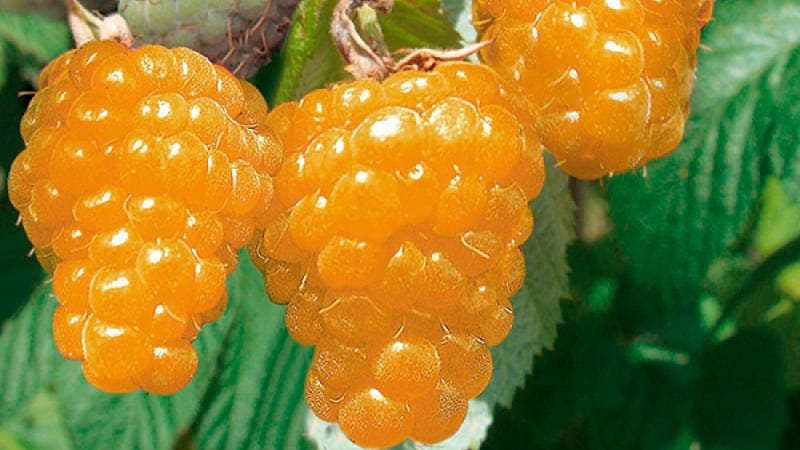
Origin and distribution
The Golden Autumn variety has another name - Golden September. It was selected using the free pollination method, selection 113-39-11. Since 2001, it has been listed in elite varieties under number 24-1392.
Breeders Sergey Evdokimov and Ivan Kazakov, employees of the Kokinsky stronghold of the All-Russian Selection and Technological Institute of Horticulture and Nursery Science (Bryansk region), are the creators of this variety.
Since 2008, Golden Autumn has been recommended for gardening throughout the Russian Federation. For 11 years, this variety has won fans in the central and southern regions of Russia: Bryansk, Belgorod, Voronezh, Vladimir, Ivanovo, Kursk, Kaluga, Lipetsk, Oryol, Moscow, Ryazan, Smolensk, Rostov, Tula, Tambov, as well as in Alania, Adygea , Dagestan, Ingushetia, Kabardino-Balkaria, Chechnya, Crimea, Stavropol and Krasnodar Territories.
Reference. The remontant raspberry variety Golden Autumn is not used for industrial production, although the variety's yield is average - up to 15 tons per hectare.
Peculiarities
The peculiarity of these yellow raspberries is that they are sweeter than ordinary red ones.. And at the same time hypoallergenic. Golden autumn can be eaten by allergy sufferers, small children and pregnant women. It does not cause redness of the skin or gastrointestinal upset.

Characteristics
The Golden Autumn raspberry variety is characterized by excellent taste and large berries.
Detailed description of the variety is in the table.
| Characteristic | Description |
| Form | An elongated cone with slight pubescence, the number of drupes is average, they are tightly connected to each other. The berries are firmly connected to the stalk, so they do not fall off. |
| Color | Rich yellow |
| Pulp | Dense, juicy |
| Taste | Sweet, with pleasant sourness |
| Berry weight | From 4.5 to 7 g |
| Productivity | 2-2.5 kg per bush |
| Ripening period | In early - mid-August, fruiting continues until frost. |
| Bush height | Up to 2 m, forms young shoots well (up to 7 per bush) |
| Escapes | Annuals are thin, greenish, drooping. Biennials are erect, with a slight waxy coating, and brown. There are few thorns, they are located at the bottom of the shoots. |
| Leaves | Dense, spreading, wrinkled |
| Winter hardiness | Below the average. The critical temperature for roots and bushes is frost below –22°C. The bush tolerates a decrease in temperature to –30°C only if the cold snap is short-lived and is not accompanied by sudden changes from frost to thaw. |
| Resistance to diseases and pests | Below the average |
Advantages and disadvantages
The raspberry variety has Golden Autumn many advantages for which gardeners and gardeners love it:
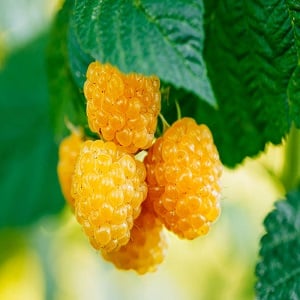 good external, taste qualities;
good external, taste qualities;- the pulp has a dense consistency, the berries do not wrinkle during transportation even over long distances, they retain their taste and presentation;
- the fruits are eaten in their natural form, made into jam, and frozen for the winter;
- Compared to traditional red raspberries, golden berries have a higher vitamin C content.
Flaws:
- medium-sized berries;
- low yield;
- does not tolerate drought - without watering the yield decreases;
- low winter hardiness and wind resistance;
- weak immunity to diseases and pests.
Preparation of planting material and soil
Favorable time for planting raspberries of the Golden Autumn variety is September and October. Then the seedlings take root and produce a harvest next year. The shoots of seedlings must be straight and without damage.
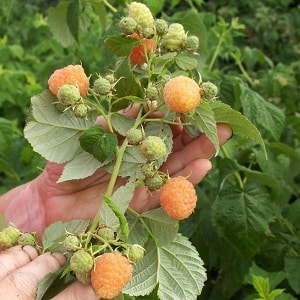 The roots should not have dried areas. When purchasing seedlings with an open root system, that is, freshly dug, pay attention so that the root system is not overdried and then moistened. These seedlings will die. Only if, after digging and pruning, the root system of the seedling is dipped into a clay mash of the consistency of sour cream, and then placed in bunches in plastic bags and stored in a cool place, the survival rate of seedlings is high.
The roots should not have dried areas. When purchasing seedlings with an open root system, that is, freshly dug, pay attention so that the root system is not overdried and then moistened. These seedlings will die. Only if, after digging and pruning, the root system of the seedling is dipped into a clay mash of the consistency of sour cream, and then placed in bunches in plastic bags and stored in a cool place, the survival rate of seedlings is high.
Seedlings with a closed root system, i.e. placed in a drainage container, even with thin and weak stems take root better. White young roots should be sticking out of the holes. If a seedling is taken out of a container, and the earthen ball in which the roots are hidden is dense, does not fall apart, and contains small weeds, this indicates that the seedling was grown in this container and has not been transplanted.
Important! Raspberry seedlings are not purchased or planted during the growing season (spring and summer), as they may not take root.
In the area where it is planned to plant Golden Autumn, the ground is dug up and weeds are removed. Per 1 m², add 2 buckets of humus and 300 g of complex mineral fertilizers, which contain nitrogen, phosphorus, potassium, and magnesium. Acidic soil is limed. The variety loves light, well-fertilized, fertile soil.
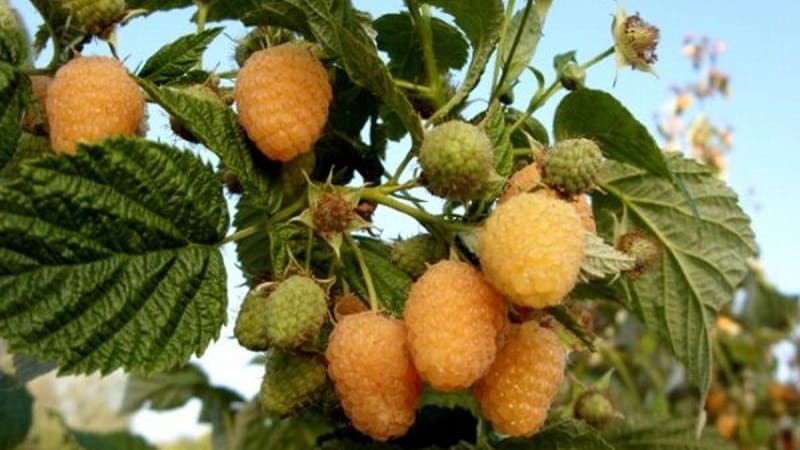
Landing technology
Saplings with an open root system are immersed in water for 2-3 days and a root growth stimulator is added., and with it closed, water it generously and carefully remove it from the container.
Golden autumn takes root and bears fruit better in sunny areas and slightly moist soils. Before planting, it is important to make sure that groundwater flows deeper than 1 m from the roots of the bush. Raspberries grow best near the wall of a house or fence - there are no drafts and winds, which they do not like.
Good predecessors – mustard, lupine, rye and peas. The bad ones are potatoes, tomatoes and peppers.
When planting in groups, dig a hole and plant four bushes per 1 m². When planting in rows, 1 bush is planted in a hole at a distance of 70 cm, leaving 100-120 cm between rows. If the seedling is tall, it is pruned at the height of two or three buds. The shoots are sprinkled, the soil is compacted and watered (5 liters of water per plant), then mulched with peat.
Important! The seedling is pruned on the same surface as the soil. In this case, it is mulched with humus and soil.
Growing and care
Any variety of raspberry requires careful care, which consists of: pruning, watering, replanting, thinning, loosening, fertilizing, pre-winter treatment and pest protection.
Watering
In dry conditions, the Golden Autumn variety reduces yields: the berries dry out, don’t grow, and fall off. The soil under the plants should always be moist.However, you cannot fill it with excess water, otherwise the roots will rot.
Water the soil with warm water until it becomes moist 30 cm deep.. Watering frequency is once a week. If there is no rain, the frequency of watering is increased.
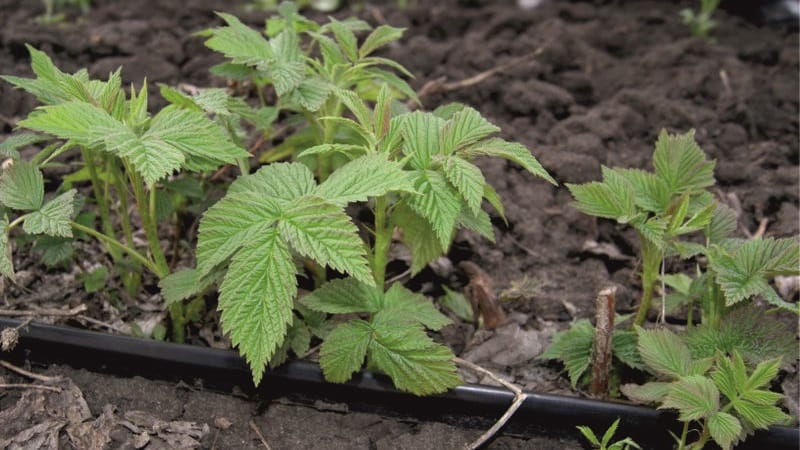
Trimming
Two prunings per year are required.. The first is in the spring, during the period of bud formation, the second - in the falluntil the first frost. Spring pruning rids the bush of frozen and damaged branches. The procedure is carried out when the kidneys are already swollen. All branches that do not have buds are cut off - they are lifeless.
In mid-autumn, after harvesting, bushes that have reached two years of age are shortened. Leave 5-7 cm from ground level. Remove weak, thin branches and young shoots, leaving 5-6 large shoots. If raspberries are not pruned in the fall, the bushes will not grow.
Advice. Pruning is done with a special garden pruner so as not to damage the branches.
Transplantation and thinning
Golden autumn tolerates transplantation well. It is carried out simultaneously with thinning, which results in 8-9 healthy shoots per 1 m². The rest are removed or transplanted elsewhere. Raspberry trees are completely replanted once every 10 years in early spring or autumn.
Loosening
The first loosening is carried out in the spring before the buds swell. Loosen the soil to a depth of 8 cm, while removing weeds. The roots are saturated with oxygen, and the shoots quickly grow. A signal that loosening is required is a dry crust on the surface of the soil under the bush.
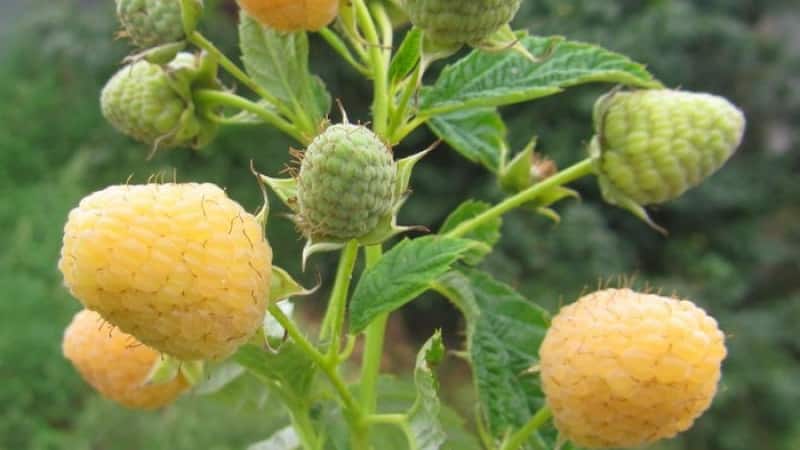
Top dressing
If all recommendations are followed when planting, the plant will have enough nutrients for two seasons.. From the third, organic matter is added. An aqueous solution of mullein in a ratio of 1:10 is used 2-3 times per season in the active growth phase.
Mineral fertilizers, for example, Nitroammofoska, are applied in the spring after the snow melts. In autumn time raspberries are fed phosphorus and potassium fertilizers.
Shelter for the winter
In the northern regions of Russia, where winter frosts range from –22 to –30°C, Golden Autumn bushes provide shelter. If pruning has not been carried out, they are bent to the ground and fixed with metal rods. The raspberries are covered with non-woven material, the roots are covered with sawdust, hay or leaves.
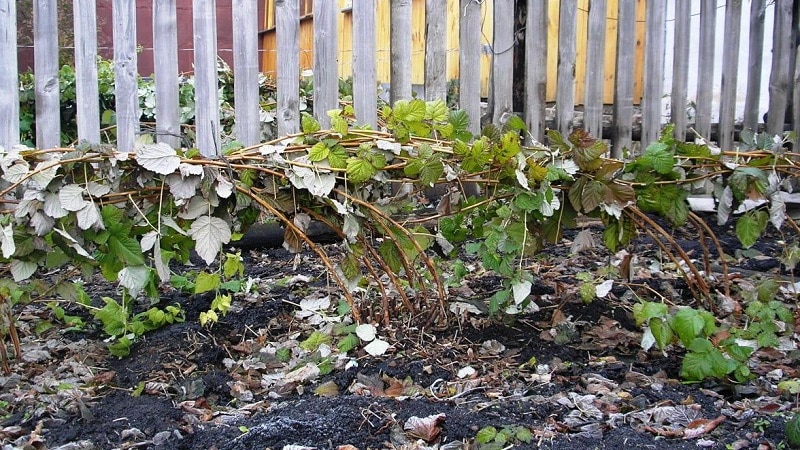
Protection from diseases and pests
Golden Autumn has low immunity to diseases and pests, therefore, preventive treatment of the bushes is required in the spring, before the buds bloom. The second and third spraying is carried out before the berries begin to set.
Important! During flowering, plants should not be treated with chemicals. Prevention is carried out before flowering begins or is postponed until after its completion.
Preparations for processing this variety must have insecticidal (control of insect pests), fungicidal (antifungal) and acaricidal (against ticks) effects.
This variety is attacked by all three types of pathogens.
| Comprehensive protection of bushes | Insecticidal preparations for raspberries | Fungicidal preparations for raspberries | Anti-tick medications |
| "Brunka", "Oleocuprite", "Sulfazin" | “Opercat”, “Inva-Vir”, “Calypso”, “Karate”, “Kung Fu” | “Fundazol”, “Quadris”, “Switch”, “Topsin M”, “Fital” | "Ortus", "Omite", "Taurus"
|
Golden autumn is less susceptible to diseases and pest invasions if The planting site is chosen correctly and proper care of the plant is provided.
Take note:
Reviews from gardeners
Gardeners who grow this variety on their plots note the bushes’ resistance to adverse weather conditions and the pleasant taste of the berries.
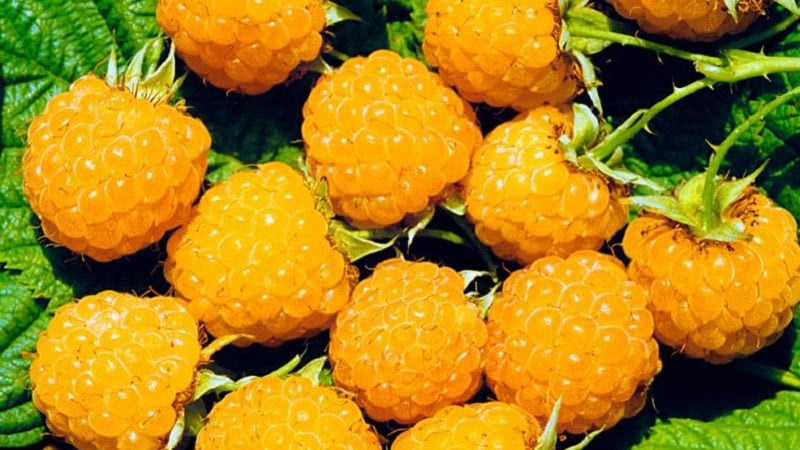
Sergey, Ust-Luga: “One of the best varieties of remontant raspberries. Planted it in a sunny place in the corner of the garden, where it is not windy. I fertilized according to schedule and did the pruning. From the end of summer until the very frosts, the whole family collected the harvest.”.
Ekaterina, Sosnovka: “I bought Golden Autumn seedlings at a gardening fair. The seller was so praising! I wasn't disappointed. This is the third year we have been enjoying delicious yellow berries. Last autumn was very cold and rainy, we thought we wouldn’t really eat any berries. But the raspberry tree delighted us until the frosts.”.
Maria, Tomsk: “I found information about the Golden Autumn variety on the Internet and wanted to plant it on my plot. I bought it, planted it in the fall and waited for it to grow. Unfortunately, it was also a cold winter, so I was worried whether the young bushes would be able to survive. To my surprise, not a single seedling was harmed. The raspberries have grown spreading and tall, the berries are juicy and sweet. I love making jam from them; it looks very unusual in jars.”.
Conclusion
The Golden Autumn raspberry variety takes root well, bears fruit well, and most importantly, produces delicious berries of an unusual yellow color. But you can get a good harvest only with proper soil preparation, compliance with planting, cultivation and care technologies.